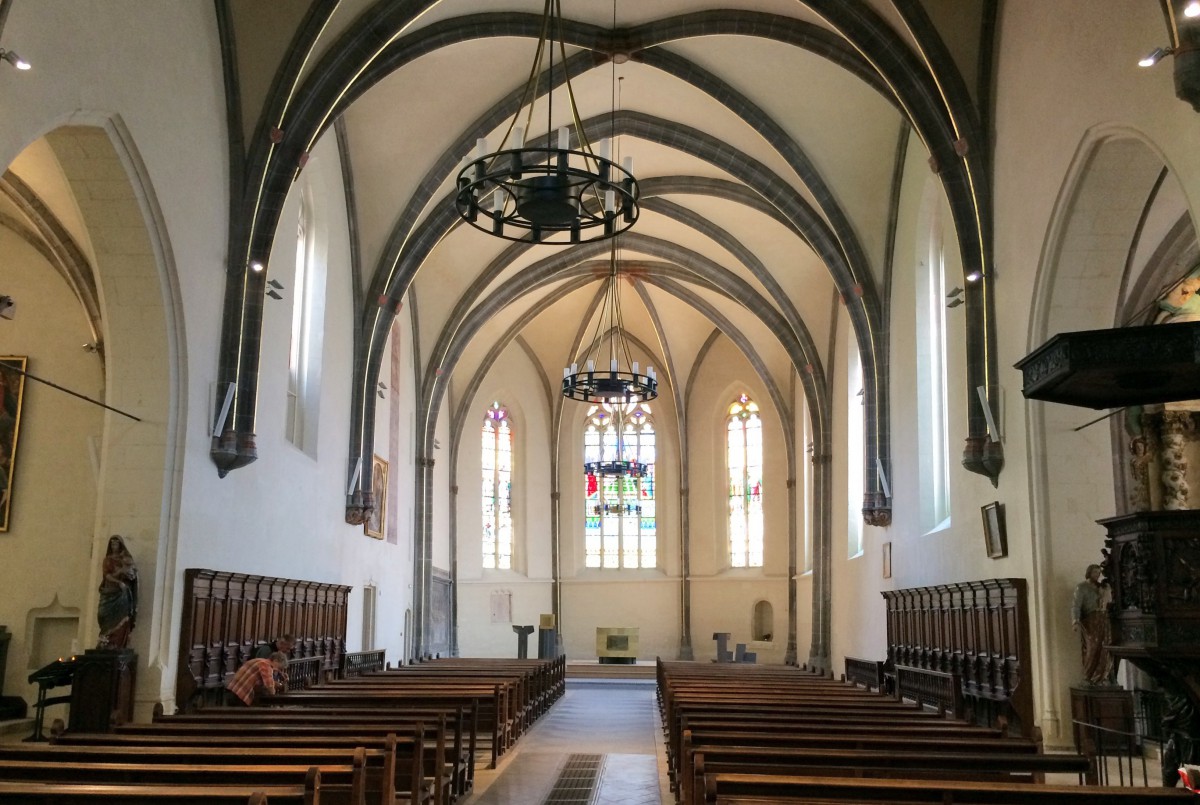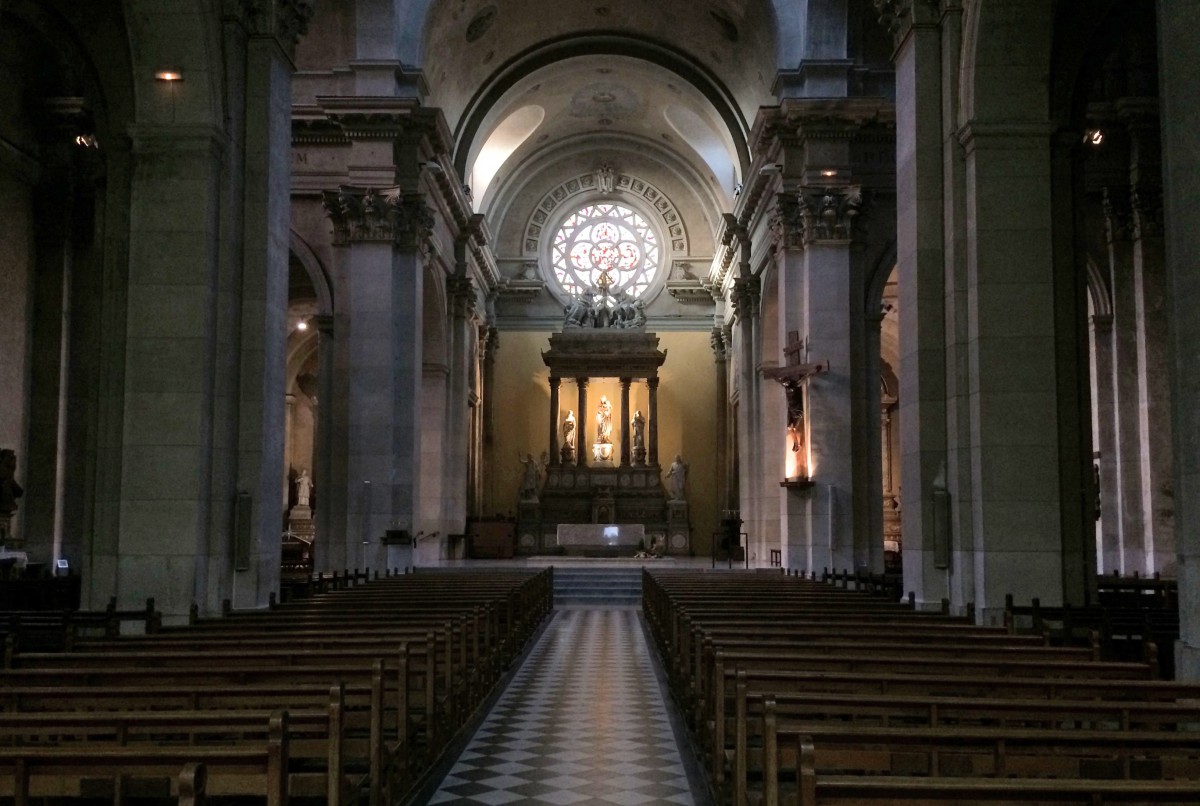The Annecy churches are beautiful Catholic sanctuaries found in the old town. In the 1530s, the events of the Reformation propelled Annecy to centre stage in the Catholic lands of the Duchy of Savoy. The bishop of Geneva was evicted from the Swiss city which had adhered to the ideals of Calvin. He took refuge in the nearby town of Annecy. As the new seat of the diocese of Geneva, Annecy became a strategic centre of the Counter Reformation, particularly with the leadership of St François de Sales. This resulted in the building or maintenance of many churches and religious orders.
Situation Map of Annecy churches

St. François de Sales Church

The church was built on the site of a church appointed to the convent of the Order of the Visitation which was founded by St François de Sales and Jeanne de Chantal in 1610. It was decided to rebuild the church in 1644 in Baroque, the architectural style of the Counter Reformation. The sanctuary became a pilgrimage site when it housed the remains of its founders.
The events of the French Revolution led to its desecration and the church became a factory for printed calico. The edifice returned to its religious use in 1888 when a private limited company, led by a canon from Quincy, bought it back. Major restoration work took place in the 1890s such as the reconstruction of the chancel and the high altar. A copy of the original altar retable was installed in 1889. In 1923, the church was given to the Italian community.
St. Maurice Church

Built around 1422 by Cardinal Jean de Brogny above the St Maurice canal, the Flamboyant edifice was the former chapel of the Dominican convent. The oldest church in Annecy was dedicated to St Maurice, the Patron Saint of Annecy and Savoy. The large overhanging roof is typical of Savoyard Gothic architecture. In the 15th and 16th centuries, the central position of St Maurice prompted the craft guilds and noble families to flank the nave with side chapels. St François de Sales made his First Communion in the church and later started to preach there.
The bell tower was initially built in around 1450 but was partially dismantled during the French Revolution. It was restored to its current state in 1827.
Notre-Dame de Liesse Church

The monumental neo-classical church was rebuilt between 1846 and 1851 after the previous edifice was demolished during the French Revolution. The only original element is the 16th century bell tower.
The façade is typical of Sardinian neo-classical style with the sober façade surmounted by a classical pediment, but also its cruciform arrangement, the semicircular arches and semicircular window openings.
The bell tower was built in 1539 on a base from the 14th century. The 21 metre spire was added in 1877.
Inside, the elaborate high altar is dedicated to Notre-Dame de Liesse.
St. Pierre Cathedral

Initially, the church was destined to serve as a chapel for a nearby convent, the Franciscan monastery, which opened in Annecy at the beginning of the 16th century.
The church was dedicated in 1539 to the Holy Cross and St Francis of Assisi and this can be seen engraved on the façade. Although the façade displays a Renaissance style, the interior and the chevet are of Gothic style architecture.
When the bishop was evicted from Geneva during the Reformation, he made the Franciscan chapel of Annecy his episcopal seat. The church became the provisional cathedral of the bishops of Geneva.
During the French Revolution the church served as a temple to the Goddess of Reason. It was only in 1822 that the church became a cathedral for the Annecy Diocese.
In the nave, a pulpit from the 18th century depicts St François de Sales preaching before the Senate of Savoy.
The apse is adorned with a marble imitation stucco sculpted between 1776 and 1780 by Master Aguisetti from Turin.
The great organ was made by Nicolas-Antoine Lété in 1840-1842 and contains 32 stops.
The small bell tower next to the choir houses two bells from the Paccard bell foundry.
Visitation Basilica

Perched on a high hill, this symbol of the town’s prestigious religious past proudly overlooks the whole city of Annecy and its surroundings.
The neo-Romanesque church is situated next to the monastery of the Order of the Visitation which was founded in 1610 by François de Sales and Jeanne de Chantal.
Inside the basilica, the stained-glass windows retrace the lives of St François de Sales and Jeanne de Chantal who rest in gilt copper sarcophaguses at the top of the side aisles.
The bell tower is 72 metres high and houses a great carillon of 38 bells moulded by the Paccard bell foundry.
The esplanade in front of the basilica offers a fine view over Annecy Castle, the town and its suburbs and the lake.
Annecy churches: English-French Vocabulary

(f) for féminin, (m) for masculin, (adj) for adjective and (v) for verbs
- Alps = Alpes (f,p)
- altar = autel (m)
- Annecy churches = églises d’Annecy (f,p)
- apse = abside (f)
- basilica = basilique (f)
- bell = cloche (f)
- bell tower = clocher (m)
- bishop = évêque (m)
- cathedral = cathédrale (f)
- chancel = chœur (m)
- chapel = chapelle (f)
- church = église (f)
- convent = couvent (m)
- Counter-Reformation = Contre-Réforme (f)
- to dedicate = dédier / dévouer (v)
- diocese = diocèse (m)
- façade = façade (f)
- Geneva = Genève
- monastery = monastère (m)
- nave = nef (f)
- pilgrimage = pèlerinage (m)
- pulpit = chaire (f)
- Reformation = Réforme (f)
- Sardinia = Sardaigne (f)
- Savoy = Savoie (f)
- spire = flèche (f)
- stained-glass window = vitrail (m)
- tower = tour (f)
Check out the website of the Tourist Information Centre for more info about staying in Annecy. You can book your accommodation via their website: check it out here.
Did you like what you read? If so, please share this article on Facebook or twitter! 🙂



















